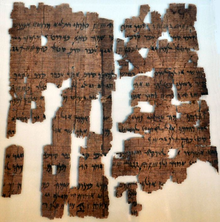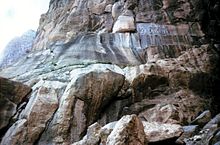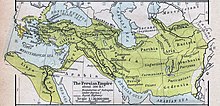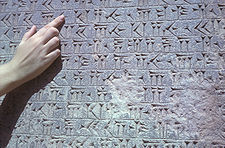Bisotun
Located on the ancient trade route that connected the Iranian plateau to Mesopotamia, Bisotun has remains from prehistoric times to the Median, Achaemenid, Sassanian and Ilkhanate periods. The main monument of this archaeological site is a bas-relief and cuneiform inscription commissioned by Darius I when he ascended the throne of the Persian Empire in 521 BC. The bas-relief depicts Darius holding a bow and arrow (as a symbol of sovereignty) and stepping on the chest of a man lying in front of him. According to legend, the figure represents Gaumeta, a wise man and pretender to the throne of Media, whose assassination led to Darius's rise to power. Under and around the bas-relief, there are about 100 cuneiform inscriptions. The 1,200-line inscription tells of Darius' battles in 521-520 BC against rulers who tried to dismantle the empire founded by Cyrus. The inscriptions are written in three languages. The oldest is the Elamite text, which mentions a legend describing the king and the rebellion. Next is the Babylonian version of a similar legend. The last part of the inscription is particularly important, as it is here that Darius first presented the Old Persian version of his res gestae (what was done). This is the only known Achaemenid monumental text that records the restoration of the empire by Darius I. It also bears witness to the exchange of influences on the development of monumental art and writing in the Persian Empire. There are also remains from the Median (8th-7th century BC), Achaemenid (6th-4th century BC) and post-Achaemenid periods.






, sketch by Friedrich von Spiegel (1881).jpg)



Poem of the heritage generated by AI
Intangible culture related to the heritage
China tourist attractions related to the heritage
World heritage related to the heritage
Information extracted from Wikidata
| location of creation | Behistun Inscription |
| KulturNav-ID | 24008 |
| IPA transcription | 1865043 |
| IPA transcription | 1865053 |
| geoshape | BehistunInscription |
| office held by head of the organization | http://g.co/kg/m/01j6b |
| Commons category | Behistun Inscription |
| language of work or name | Elamite |
| inception | -0600-01-01T00:00:00Z |
| coordinate location | Point(47.435833333 34.390555555) |
| topic's main category | Category:Behistun Inscription |
| Commons gallery | Behistun Inscription |
| described at URL | http://cdli.ox.ac.uk/wiki/doku.php?id=bisitun_inscription |
| Iranian National Heritage registration number | 70 |
| start time | 1932-01-06T00:00:00Z |
| area | 187 |
| World Heritage criteria | World Heritage selection criterion (ii) |
| directions | بیستون |
| country | Camarmilla River |
| image | http://commons.wikimedia.org/wiki/Special:FilePath/Darius%20I%20the%20Great%27s%20inscription.jpg |
| instance of | bas-relief |
| made from material | limestone |
| executive body | Behistun Inscription |
| start time | 2006-01-01T00:00:00Z |
| official name | Behistun |
| official name | بيستون |
| official name | Bisotun |
| official name | Behistún |
| official name | ビソトゥーン |
| official name | Bisotun |
| official name | Археологический объект Бисотун |
| official name | 比索顿古迹 |
| volume as quantity | World Heritage selection criterion (ii) |
| area | 361 |
| applies to part | buffer zone |